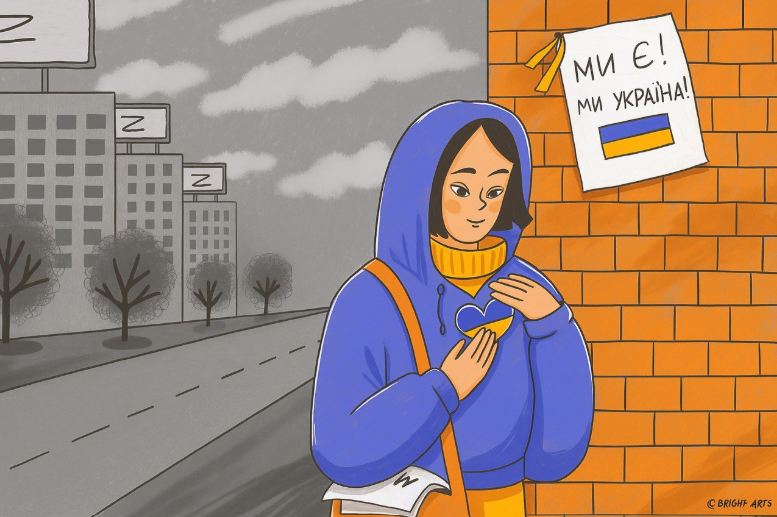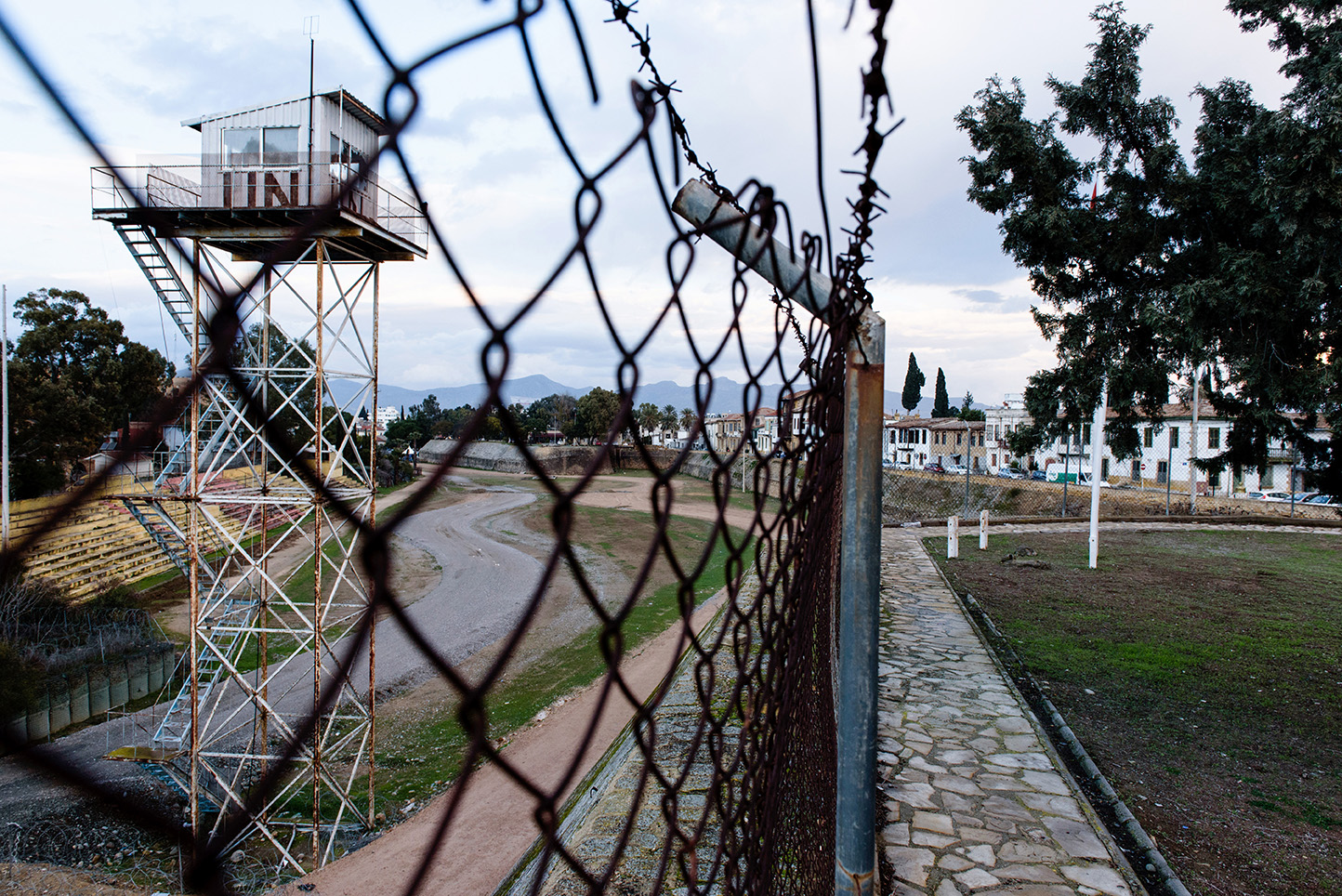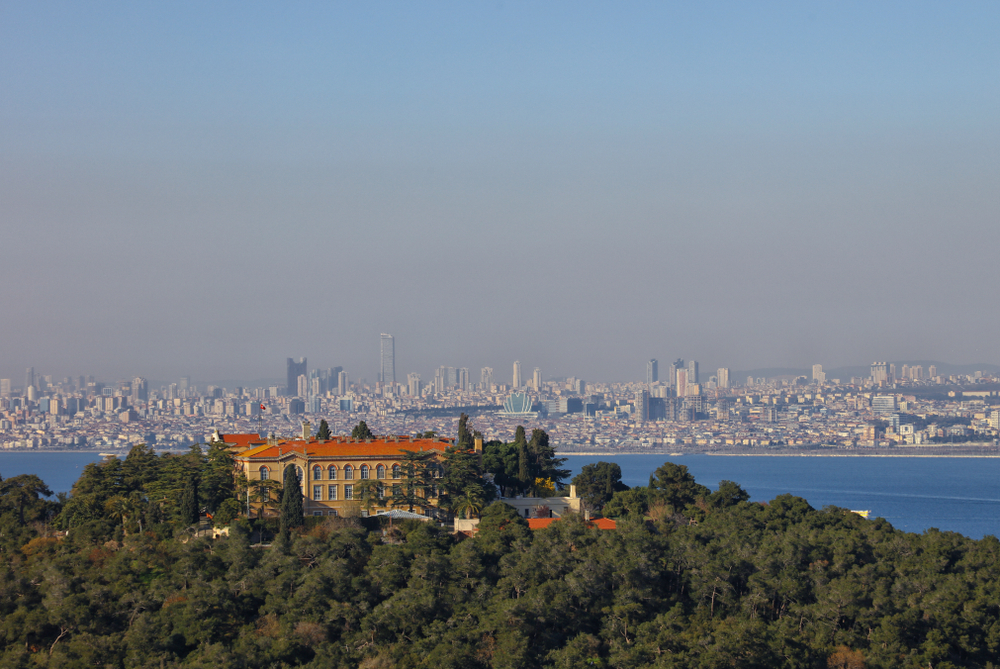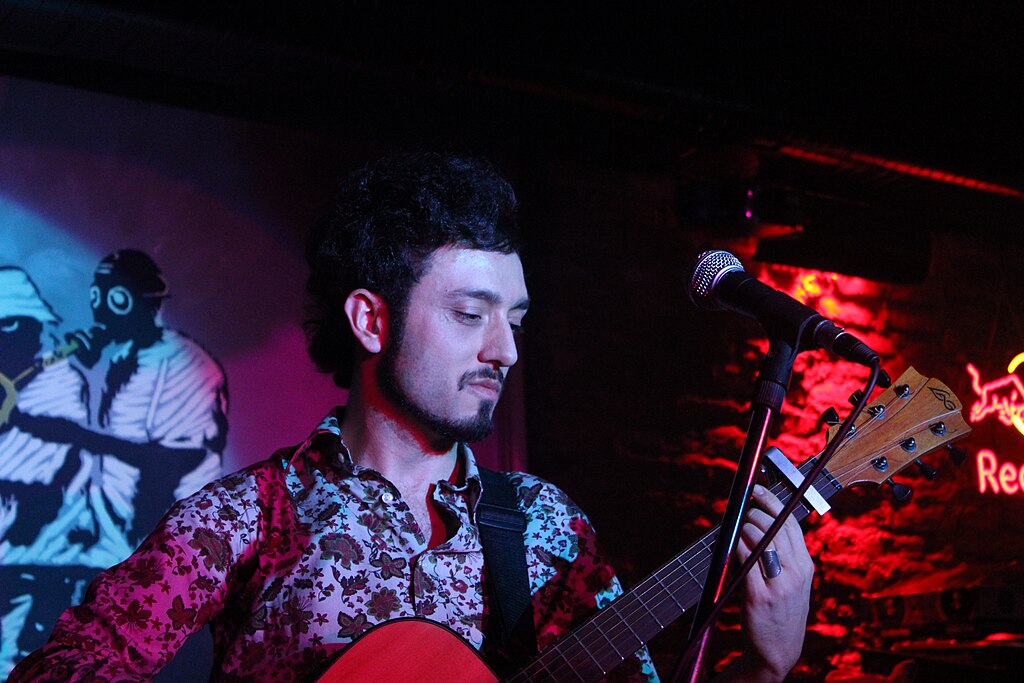From Leaflets to Sabotage: how Ukrainians are resisting Russification
While President Putin’s conditions for achieving peace with Ukraine stay unshakable amid further peace talks, civilians in occupied territories are fighting against Russification. Although rarely talked about in Western media, Ukrainians are engaging in various forms of resistance, both peaceful and violent.
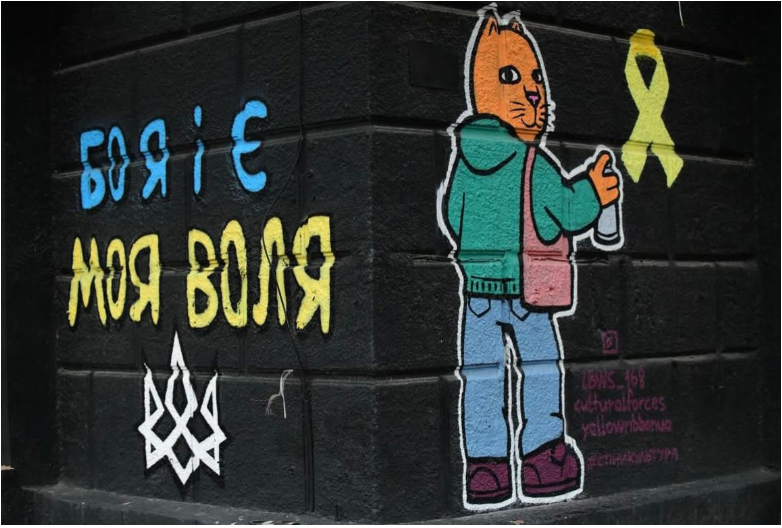
Dai-volantini-ai-sabotaggi-come-gli-ucraini-resistono-alla-russificazione-1
Graffiti of LBWS cat in Kherson, drawing a yellow ribbon on a wall as a sign of resistance to Russian occupation - © Ramina Eshakzai
President Putin insists that peace with Ukraine requires international recognition of the Crimea, and Donetsk and Luhansk regions as part of Russia following “referendums,” alongside future referendums in occupied Zaporizhzhia and Kherson regions after martial law ends.
The narrative remains the same, claiming these territories are originally Russian with close cultural ties, and their annexation protects Russian-speaking people from Kyiv’s alleged "genocide."
Although it is true that there are ethnic Russians in the temporarily occupied territories, this is, for the most part, the result of colonization by the Russian Empire, and later the USSR.
The Russian language was also native for a large part of the population due to the numerous Russification policies back then. And the longer these lands are under Russian occupation today, the more achievable Russian expansionism is.
Russification policies in the occupied territories
Indeed, the occupation authorities are trying with all their might to Russify Ukrainian cities. The local population is forced to legalize by September 10, 2025, by taking the Russian citizenship and passport, or leave the territory (Presidential decree of March 20, 2025).
All who refuse would get the status of “foreign citizens” with restrictions on long-term stay, access to work, social and medical services.
At the same time, Russia is conducting a large-scale campaign to change the demographic composition by actively resettling Russians to these territories and weakening the connection with Ukraine.
Only Ukrainians accepting Russian passportization can legally stay in the country and maintain their property in the regions, otherwise the property could be seized by the Russian occupation and sold at reduced prices for newcomers, who are also getting paid for relocation.
To make Russians move to the occupied territories, Russian influencers distort reality in their travel blogs, i.e. advertising Mariupol and showing its “re-construction”. But in reality, numerous Telegram channels show terrible living conditions with occupation powers not taking actions to provide tap and drinking water, heating, and other basic utilities.
Active Russification is also taking place at the level of children’s education. Until recently, learning Ukrainian was mandatory across temporary occupied territories of Zaporizhzhia and Kherson regions and optional in annexed Luhansk and Donetsk regions and the Crimea.
Starting September 1, 2025, Ukrainian is banned from all education institutions by Russia’s Education Ministry. Children are forced to sing the Russian anthem, propaganda programs and indoctrination sessions are being introduced, justifying the Russian “Special Military Operation” and instilling Russian ideology.
In addition, abducted children are subjected to forced ideological indoctrination in “re-education” camps, where they are taught a pro-Russian identity and prepared for service in the Russian army.
Something similar is happening in some public schools. The course “Basics of Life Safety”, where pupils are taught how to act in life threatening situations, was always part of both Ukrainian and Russian high school programs. It included first aid for girls and disassembly and assembly of the Kalashnikov assault rifle for boys.
But Russia’s training of Ukrainian children in occupied territories is going much further. Since 2024 schools run combat classes starting from the fifth grade, while combat skills are further practices in the Zarnitsa 2.0 militarized game, where children and youth are taught to use the know-how of modern warfare and how to escape from captivity.
In 2025 the game was under the mentorship of warriors with combat experience, veterans of the Special Operations, who told about their “acts of bravery.”
In general, the active introduction of Russian symbols, culture and propaganda takes place at all levels of urban life. It demonstrates loyalty to the authorities and attempts to maximally Russify the remaining Ukrainian population with the goal of full integration into Russia.
But “occupation is not just changing one flag for another”, says Matviichuk , head of the Center for Civil Liberties. Those who try to resist occupation powers and their policies are accused of espionage and become illegally imprisoned , are placed in filtration camps, or face forced disappearance.
Civilians carry on resisting in different ways
Still, there are movements that continue fighting. When faced with Russification, the Ukrainian civil society developed various strategies of coping. Some relied heavily on their community to maintain a sense of belonging and national identity, while some joined social movements trying to fight against Russification efforts and the occupation. Others decided to mobilize differently, forming partisan movements engaged in active resistance.
The most notable example is Zla Mavka , a women partisan movement that engages in non-violent resistance in the occupied city of Melitopol and throughout the occupied territories.
Inspired by Ukrainian folklore, it defies Russia’s invasion by spreading leaflets, and resistance material both online and in person. As the participants state themselves, this type of resistance mainly serves the purpose of reminding pro-Ukrainian citizens that other people too are against the occupation and Russification efforts.
But they are not the only non-violent movement present in the occupied territories. Another notable case is that of the Yellow Ribbon Movement. Born right after the Russian invasion, it uses the Telegram channel to organize non-violent actions.
Activists have coordinated numerous campaigns starting in Kherson and then spreading to the other regions. The most notable actions were centered around displaying the Ukrainian flag or yellow ribbons around various cities, and destroying Russian symbols.
In July 2022, the movement also worked on the campaign “Stop the Referendum”, spreading leaflets about the dangers of the annexation campaign. Through their Telegram channel, they were urging activists to mark buildings where the referendum would take place with the letter “Ï”, a unique letter of the Ukrainian alphabet, also contained in the world Україна (Ukraine). It later became the symbol of the movement.
Some activists have gone beyond peaceful resistance by joining civil resistance movements and para-military groups. Already at the beginning of the war, especially in occupied Kherson and Melitopol, there were numerous cases of activists kidnapping, poisoning and killing various pro-Russian officials, known supporters and Russian police patrols, mainly by ambushing them at night.
Some civilians also joined the military partisan movement called “Atesh ”. Founded in September 2022, it also uses Telegram channels to organize actions against the Russian military in the occupied regions and support Ukraine’s official army by providing intelligence.
Atesh’s leader Mustafa Dzhemilev has stated in a 2023 interview with The Guardian that the group maintains contact with 4000 Russian citizens drafted by the army and teaches them to sabotage their own equipment.
As early as 2024, the Atash movement was also able to carry out operations in Russian territory, mainly sabotaging infrastructures such as substations and railways. Recently, the movement also declared that they have a network of “ethnic Ukrainians” dispersed for various reasons across Russia, which have remained faithful to their country and are ready to act from within.
They claim this network was responsible for providing intelligence that helped strike the Russian Black Sea Fleet, and the "Kremniy El" plant in Bryansk (Russia), targeted multiple times in 2025 with drones.
The risks in resisting
Of course, participating in such partisan activities is extremely dangerous, as well as taking actions in non-violent initiatives.
Recently, two Ukrainian journalist , Heorhiy Levchenko and Vladyslav Hershon, have been sentenced to 16 and 15 years respectively, convicted of “high treason,” “incitement to extremism,” and “terrorism” for “spreading pro-Ukrainian propaganda and transmitting information to Ukrainian intelligence services regarding deployment of Russian armed forces.”
There are a number of cases of activists being fined or sentenced for hate speech against occupation and pro-Ukrainian behaviours, as well as forced disappearances .
While Russian forces try to contain resistance and partisan movements in the occupied territory through detention and repression, it is clear that they will only become bigger if the recent talks about annexing occupied regions go further.
In fact, some of these movements were already present before the 2022 invasion, with some underground formations going back to 2014, when Russia annexed Crimea. Only after the full-scale invasion, these movements substantially grew in number becoming an important piece of the puzzle in the current war between Kyiv and Moscow.
It is not clear though whether these movements remain a civil society’s effort, or if they are supported or integrated in the official military of Ukraine. On January 1, 2022, a national law entered into force in Ukraine creating the National Resistance Center, which claims to be coordinating partisan groups and teaching non-violent resistance.
So, especially in the case of para-military movements like Atesh, it is questionable if they still can be considered a civilian effort, or a self-standing military group following military orders.
Taking various forms, peaceful and violent, Ukrainian resistance is praised as courageous and necessary to oppose Russian aggression, both in the country and abroad.
To date, no Western leader has challenged the use of force by civilians against Russians, nor has anyone questioned, at least publicly, whether violence is the right means to respond to occupation.
On the contrary, civil resistance has been rightly celebrated as a necessary form of self-defense. The line between these two forms of opposition, however, is blurry and has many implications. While unarmed resistance is considered civil disobedience, armed resistance shifts the struggle to a different level.
Under international humanitarian law, a civilian who takes up arms against an occupier is not always protected and may become a legitimate target in some cases. Therefore, this choice, dictated by the need to survive, carries a very high risk and raises many questions about the legitimacy of violence by civilians in wartime.
What is certain is that the double standard is difficult to ignore. When compared to other conflicts, the Ukrainian resistance, both armed and unarmed, raises many questions about when and how it is acceptable, from a Western perspective, to resist.
From Leaflets to Sabotage: how Ukrainians are resisting Russification
While President Putin’s conditions for achieving peace with Ukraine stay unshakable amid further peace talks, civilians in occupied territories are fighting against Russification. Although rarely talked about in Western media, Ukrainians are engaging in various forms of resistance, both peaceful and violent.

Dai-volantini-ai-sabotaggi-come-gli-ucraini-resistono-alla-russificazione-1
Graffiti of LBWS cat in Kherson, drawing a yellow ribbon on a wall as a sign of resistance to Russian occupation - © Ramina Eshakzai
President Putin insists that peace with Ukraine requires international recognition of the Crimea, and Donetsk and Luhansk regions as part of Russia following “referendums,” alongside future referendums in occupied Zaporizhzhia and Kherson regions after martial law ends.
The narrative remains the same, claiming these territories are originally Russian with close cultural ties, and their annexation protects Russian-speaking people from Kyiv’s alleged "genocide."
Although it is true that there are ethnic Russians in the temporarily occupied territories, this is, for the most part, the result of colonization by the Russian Empire, and later the USSR.
The Russian language was also native for a large part of the population due to the numerous Russification policies back then. And the longer these lands are under Russian occupation today, the more achievable Russian expansionism is.
Russification policies in the occupied territories
Indeed, the occupation authorities are trying with all their might to Russify Ukrainian cities. The local population is forced to legalize by September 10, 2025, by taking the Russian citizenship and passport, or leave the territory (Presidential decree of March 20, 2025).
All who refuse would get the status of “foreign citizens” with restrictions on long-term stay, access to work, social and medical services.
At the same time, Russia is conducting a large-scale campaign to change the demographic composition by actively resettling Russians to these territories and weakening the connection with Ukraine.
Only Ukrainians accepting Russian passportization can legally stay in the country and maintain their property in the regions, otherwise the property could be seized by the Russian occupation and sold at reduced prices for newcomers, who are also getting paid for relocation.
To make Russians move to the occupied territories, Russian influencers distort reality in their travel blogs, i.e. advertising Mariupol and showing its “re-construction”. But in reality, numerous Telegram channels show terrible living conditions with occupation powers not taking actions to provide tap and drinking water, heating, and other basic utilities.
Active Russification is also taking place at the level of children’s education. Until recently, learning Ukrainian was mandatory across temporary occupied territories of Zaporizhzhia and Kherson regions and optional in annexed Luhansk and Donetsk regions and the Crimea.
Starting September 1, 2025, Ukrainian is banned from all education institutions by Russia’s Education Ministry. Children are forced to sing the Russian anthem, propaganda programs and indoctrination sessions are being introduced, justifying the Russian “Special Military Operation” and instilling Russian ideology.
In addition, abducted children are subjected to forced ideological indoctrination in “re-education” camps, where they are taught a pro-Russian identity and prepared for service in the Russian army.
Something similar is happening in some public schools. The course “Basics of Life Safety”, where pupils are taught how to act in life threatening situations, was always part of both Ukrainian and Russian high school programs. It included first aid for girls and disassembly and assembly of the Kalashnikov assault rifle for boys.
But Russia’s training of Ukrainian children in occupied territories is going much further. Since 2024 schools run combat classes starting from the fifth grade, while combat skills are further practices in the Zarnitsa 2.0 militarized game, where children and youth are taught to use the know-how of modern warfare and how to escape from captivity.
In 2025 the game was under the mentorship of warriors with combat experience, veterans of the Special Operations, who told about their “acts of bravery.”
In general, the active introduction of Russian symbols, culture and propaganda takes place at all levels of urban life. It demonstrates loyalty to the authorities and attempts to maximally Russify the remaining Ukrainian population with the goal of full integration into Russia.
But “occupation is not just changing one flag for another”, says Matviichuk , head of the Center for Civil Liberties. Those who try to resist occupation powers and their policies are accused of espionage and become illegally imprisoned , are placed in filtration camps, or face forced disappearance.
Civilians carry on resisting in different ways
Still, there are movements that continue fighting. When faced with Russification, the Ukrainian civil society developed various strategies of coping. Some relied heavily on their community to maintain a sense of belonging and national identity, while some joined social movements trying to fight against Russification efforts and the occupation. Others decided to mobilize differently, forming partisan movements engaged in active resistance.
The most notable example is Zla Mavka , a women partisan movement that engages in non-violent resistance in the occupied city of Melitopol and throughout the occupied territories.
Inspired by Ukrainian folklore, it defies Russia’s invasion by spreading leaflets, and resistance material both online and in person. As the participants state themselves, this type of resistance mainly serves the purpose of reminding pro-Ukrainian citizens that other people too are against the occupation and Russification efforts.
But they are not the only non-violent movement present in the occupied territories. Another notable case is that of the Yellow Ribbon Movement. Born right after the Russian invasion, it uses the Telegram channel to organize non-violent actions.
Activists have coordinated numerous campaigns starting in Kherson and then spreading to the other regions. The most notable actions were centered around displaying the Ukrainian flag or yellow ribbons around various cities, and destroying Russian symbols.
In July 2022, the movement also worked on the campaign “Stop the Referendum”, spreading leaflets about the dangers of the annexation campaign. Through their Telegram channel, they were urging activists to mark buildings where the referendum would take place with the letter “Ï”, a unique letter of the Ukrainian alphabet, also contained in the world Україна (Ukraine). It later became the symbol of the movement.
Some activists have gone beyond peaceful resistance by joining civil resistance movements and para-military groups. Already at the beginning of the war, especially in occupied Kherson and Melitopol, there were numerous cases of activists kidnapping, poisoning and killing various pro-Russian officials, known supporters and Russian police patrols, mainly by ambushing them at night.
Some civilians also joined the military partisan movement called “Atesh ”. Founded in September 2022, it also uses Telegram channels to organize actions against the Russian military in the occupied regions and support Ukraine’s official army by providing intelligence.
Atesh’s leader Mustafa Dzhemilev has stated in a 2023 interview with The Guardian that the group maintains contact with 4000 Russian citizens drafted by the army and teaches them to sabotage their own equipment.
As early as 2024, the Atash movement was also able to carry out operations in Russian territory, mainly sabotaging infrastructures such as substations and railways. Recently, the movement also declared that they have a network of “ethnic Ukrainians” dispersed for various reasons across Russia, which have remained faithful to their country and are ready to act from within.
They claim this network was responsible for providing intelligence that helped strike the Russian Black Sea Fleet, and the "Kremniy El" plant in Bryansk (Russia), targeted multiple times in 2025 with drones.
The risks in resisting
Of course, participating in such partisan activities is extremely dangerous, as well as taking actions in non-violent initiatives.
Recently, two Ukrainian journalist , Heorhiy Levchenko and Vladyslav Hershon, have been sentenced to 16 and 15 years respectively, convicted of “high treason,” “incitement to extremism,” and “terrorism” for “spreading pro-Ukrainian propaganda and transmitting information to Ukrainian intelligence services regarding deployment of Russian armed forces.”
There are a number of cases of activists being fined or sentenced for hate speech against occupation and pro-Ukrainian behaviours, as well as forced disappearances .
While Russian forces try to contain resistance and partisan movements in the occupied territory through detention and repression, it is clear that they will only become bigger if the recent talks about annexing occupied regions go further.
In fact, some of these movements were already present before the 2022 invasion, with some underground formations going back to 2014, when Russia annexed Crimea. Only after the full-scale invasion, these movements substantially grew in number becoming an important piece of the puzzle in the current war between Kyiv and Moscow.
It is not clear though whether these movements remain a civil society’s effort, or if they are supported or integrated in the official military of Ukraine. On January 1, 2022, a national law entered into force in Ukraine creating the National Resistance Center, which claims to be coordinating partisan groups and teaching non-violent resistance.
So, especially in the case of para-military movements like Atesh, it is questionable if they still can be considered a civilian effort, or a self-standing military group following military orders.
Taking various forms, peaceful and violent, Ukrainian resistance is praised as courageous and necessary to oppose Russian aggression, both in the country and abroad.
To date, no Western leader has challenged the use of force by civilians against Russians, nor has anyone questioned, at least publicly, whether violence is the right means to respond to occupation.
On the contrary, civil resistance has been rightly celebrated as a necessary form of self-defense. The line between these two forms of opposition, however, is blurry and has many implications. While unarmed resistance is considered civil disobedience, armed resistance shifts the struggle to a different level.
Under international humanitarian law, a civilian who takes up arms against an occupier is not always protected and may become a legitimate target in some cases. Therefore, this choice, dictated by the need to survive, carries a very high risk and raises many questions about the legitimacy of violence by civilians in wartime.
What is certain is that the double standard is difficult to ignore. When compared to other conflicts, the Ukrainian resistance, both armed and unarmed, raises many questions about when and how it is acceptable, from a Western perspective, to resist.

